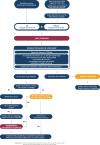Commentary: Tolvaptan for Autosomal Dominant Polycystic Kidney Disease (ADPKD) - an update
- PMID: 39953521
- PMCID: PMC11827152
- DOI: 10.1186/s12882-025-03960-4
Commentary: Tolvaptan for Autosomal Dominant Polycystic Kidney Disease (ADPKD) - an update
Abstract
Autosomal Dominant Polycystic Kidney Disease (ADPKD) affects up to 70 000 people in the UK and the most common inherited cause of end-stage kidney disease (ESKD). It is generally a late-onset multisystem disorder characterised by bilateral kidney cysts, liver cysts and an increased risk of intracranial aneurysms. Approximately 50% of people with ADPKD reach ESKD by age 60. Disease-associated pain, discomfort, fatigue, emotional distress and, impaired mobility can impact health-related quality of life. The approval of tolvaptan, a vasopressin V2 receptor antagonist, has greatly advanced the care for people with ADPKD, shifting the focus from general chronic kidney disease management to targeted therapeutic approaches. While guidance from NICE and SMC provides a foundational framework, this is not clear or comprehensive enough to offer practical guidance for healthcare professionals in real-world settings. This commentary expands on the previous United Kingdom Kidney Association (UKKA) commentary in 2016 with an updated evidence base, the incorporation of real-world data and expert opinion to provide practical guidance to healthcare professionals. Through co-development with people affected by ADPKD, it now incorporates valuable patient perspectives and offers practical recommendations for the UK kidney community seeking to harmonise the quality of care of all people with ADPKD.
Keywords: ADPKD; Autosomal Dominant polycystic kidney disease; Tolvaptan.
© 2025. Crown.
Conflict of interest statement
Declarations. Ethics approval and consent to participate: No ethical approval was sought for this study. Consent for publication: Consent for publication was given by the UKKA. Competing interests: The authors declare no competing interests.
Figures
References
-
- Ong ACM, Harris PC. Molecular pathogenesis of ADPKD: the polycystin complex gets complex. Kidney Int. 2005;67(4):1234–47. - PubMed
-
- Iglesias CG, Torres VE, Offord KP, Holley KE, Beard CM, Kurland LT. Epidemiology of adult polycystic kidney disease, Olmsted County, Minnesota: 1935–1980. Am J Kidney Dis. 1983;2(6):630–9. - PubMed
-
- Solazzo A, Testa F, Giovanella S, Busutti M, Furci L, Carrera P, et al. The prevalence of autosomal dominant polycystic kidney disease (ADPKD): a meta-analysis of European literature and prevalence evaluation in the Italian province of Modena suggest that ADPKD is a rare and underdiagnosed condition. PLoS ONE. 2018;13(1):e0190430. - PMC - PubMed
-
- Neumann HP, Jilg C, Bacher J, Nabulsi Z, Malinoc A, Hummel B, et al. Epidemiology of autosomal-dominant polycystic kidney disease: an in-depth clinical study for south-western Germany. Nephrol Dialysis Transplant. 2013;28(6):1472–87. - PubMed
Publication types
MeSH terms
Substances
LinkOut - more resources
Full Text Sources




